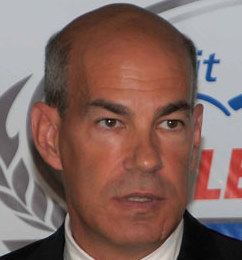Atherton underscores vital role of racing in innovation
 |
| Scott Atherton |
As they have for many, many years, every race car in last Saturday's TUDOR United SportsCar Championship race at Circuit of The Americas had a rearview mirror. That's not news, as a rearview mirror is a simple, obvious and essential part of any automobile.
But as IMSA President and Chief Operating Officer Scott Atherton pointed out last week in a keynote address to the SAE North American International Powertrain Conference in Chicago, the rearview mirror is one of the most basic examples of automobile innovation driven by racing.
In a presentation titled "Roadmaps for the Future: Challenging Conventional Wisdom," Atherton noted that the addition of a rearview mirror actually dates to the first Indianapolis 500.
"The Conventional Wisdom of the day dictated a race driver needed a riding mechanic to communicate what was going on around him and most importantly what was coming up from behind," Atherton said during his opening remarks at the Westin Chicago River North.
"Made perfect sense. Until Ray Harroun installed a rearview mirror and won the first ever Indy 500 alone in the car. … A racing-inspired innovation that was immediately adopted for consumer use and continues today as a ubiquitous feature on every automobile made."
In a broader sense, Atherton said, racing is the essential element that drives technological advancement in production cars by challenging the status quo, the conventional wisdom of the day. The sport of auto racing is rife with examples, from the lightweight rear-engine Cooper Climax introduced by Jack Brabham at Indianapolis to the aerodynamic breakthrough embodied in the Chaparral to the development of leading-edge hybrid technology in racing today.
"For many, competing at the highest level of sports car racing is in the DNA of the brand," Atherton said. "It is the very definition of racing what they sell. And, done right, it is the race car that is driving the advancement and ultimately the success of the road car version.
"One of the best in the business at transferring technology and innovation from race car to road car is Chevrolet with their Corvette. From the aero treatment of the headlights and bodywork to the lightweight carbon fiber panels, there is now more race car content in the Corvette road car than ever before.
"Think this approach is working? You bet it is – critical acclaim for the Corvette has never been more positive, and customer demand and sales are at modern-day record levels."
In order to be a viable platform for the retail automobile industry, Atherton said, a racing series must fulfill four essential requirements:
• It must attract the investment of the OEM industry and therefore must provide the required return on investment;
• It must be an educational tool that fascinates the audience;
• It must be economically self-sustaining as a business model;
• And it must inspire and provide the opportunity for the Industry to develop relevant future technologies.
"Regarding a motorsports platform that features those four critically important criteria, I would say to you: ‘We've already got one,'" Atherton said, referencing IMSA's TUDOR United SportsCar Championship.
"After 15 years of fragmentation, professional sports car racing in North America has united. Some have said that this merger has put professional sports car racing back into the position, sanctioned by IMSA, the way that God intended–and I would agree."
The inaugural TUDOR Championship season concludes on Saturday, Oct. 4 with the 10-hour Petit Le Mans powered by Mazda at Road Atlanta, which starts at 11 a.m. ET. Live streaming of the race is available on IMSA.com, with live FOX Sports 2 television coverage beginning at 3 p.m. ET.
Petit Le Mans also will be featured on FOX with a two-hour telecast on Sunday, Oct. 5 around the network's NFL coverage. Check local listings for the time in your area.
